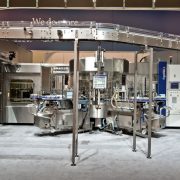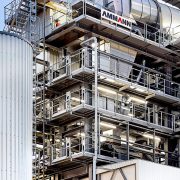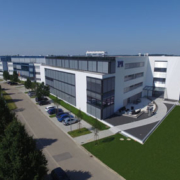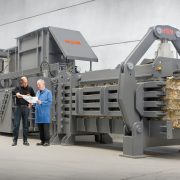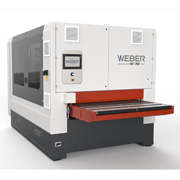Success Story HAUNI: Hunting Cost Drivers
Hauni achieves transparency for a reduction of manufacturing costs at an early stage with CAD-integrated calculation software
In machines for filter and cigarette manufacturing alone, Hauni Maschinenbau GmbH based in Hamburg produces 30,000 new parts per year – each machine contains between 2,000 and 4,000 manufactured parts. In this case, transparency in manufacturing costs pays off: The CAD-integrated simus classmate software suite by simus systems currently calculates 80 percent of parts automatically with an accuracy rate of 95 percent.
As part of the Körber AG, Hauni Maschinenbau GmbH founded in 1946 develops and manufactures solutions for the global tobacco industry as the leading brand of the business area tobacco. In addition to primary plants for tobacco treatment, secondary machines for filter and cigarette production are developed in Germany and Hungary: Customer-specific technical solutions which are characterized by outstanding technology and quality are developed for all core processes, e.g., the production of filters, multi filters and cigarettes, as well as logistics. Furthermore, approximately 250 designing engineers develop about 30,000 new parts per year – approximately 18 percent of the active parts inventory. For each product development, several thousand manufactured parts have to be customized and changed in multiple steps per development stage. For this purpose, you use the 3D CADCAM System NX, integrated in the PDM system Teamcenter, both presented by Siemens PLM Software.
Support Target Costing
A team of five people and managed by Tobias Müller executes the difficult task of calculating the costs of a very extensive and versatile production volume and optimizes them with the help of transparency and cost awareness. He took the suggestion to give designing engineers software for pre-calculation during the development stage from a technology cluster meeting of the Körber AG. “We can hardly reduce the cost in serial production for our batch sizes,” Tobias Müller explains. “Therefore, we want to target development where costs are determined.” In his research, he came across the simus class software suite by simus systems, an expert in handling technical mass data. A module of this software suite, classmate CAD, analyzes 3D models of any format, the classmate PLAN module subsequently allocates geometrical elements to manufacturing methods, e.g., turning, milling, or sheet metal forming. The program determines different work sequences such as sawing, turning, milling, boring, deburring, or grinding, and connects them to information on materials, machines with hourly rates, and manufacturing parameters from technology databases.
 Following the prompts of a 3D CAD system, the designing engineers can automatically calculate the estimated manufacturing costs of their parts and assemblies with classmate PLAN and integrate the display of the results in NX – even including the change history. The cost for various tolerances, materials, or surface treatments can be determined without changes in the CAD model.
Following the prompts of a 3D CAD system, the designing engineers can automatically calculate the estimated manufacturing costs of their parts and assemblies with classmate PLAN and integrate the display of the results in NX – even including the change history. The cost for various tolerances, materials, or surface treatments can be determined without changes in the CAD model.
“With these functions, designing engineers can calculate parts autonomously and meet the agreed target costs without interrupting their work,”
Tobias Müller says.
Nine-Month Project Implementation
After the strategic decision by Management to introduce the software, the implementation of simus classmate was started by a project team managed by Tobias Müller and two staff members of simus systems in January 2017. Workshops and meetings were set up to analyze the range of parts, define methods and basis for costing and describe production capabilities up to tool selection. For this reason, ten Hauni employees from various areas, buyers as well as manufacturing experts were part of the implementation team. The underlying data for costing was maintained in three technology databases. They enable calculations irrespective of the plant for designing engineers and location-based costing for Hamburg and the site in Hungary. It was discovered that product manufacturing information (PMI) – production information such as tolerance or material quality associated with the 3D model – is an important basis for costing. “So far, we passed this information on to our suppliers on production drawings,” Tobias Müller reports. “The basis was created in a big project to add PMIs to models of all new parts from the end of the year 2019. In the medium term, drawings should be dispensed with.” As not only simus classmate but CNC controls of measuring machines and machining centers process the PMIs. Commercial information such as material prices and their overhead costs are provided through integration with the ERP system by SAP. “We did not want to calculate procurement prices but measurable, technologically presentable manufacturing costs,” Tobias Müller said. “Therefore, we focus on a few realistic surcharges that are plausible without lengthy discussions.”
The project was concluded successfully within time and budget with end user workshops in September 2017.
“The collaboration with technology experts who understood our business was great,”
Tobias Müller says. “We could not have hoped for more.”
Inter-Divisional Understanding of Costs
Since then, about 50 users in Product Development can open classmate FINDER from the user guidance in NX to check on the estimated manufacturing costs of their parts and assemblies. This easy access and the automatic calculation causes aha moments, generates knowledge on calculations and strengthens cost awareness of designing engineers. Even alternative processing methods with varying accuracy, tolerances, or material quality can be simulated and evaluated separately in the change history.
“For about 80 percent of our parts, simus classmate calculates the manufacturing costs in advance with a success rate of 95 percent,”
Tobias Müller says. The Costing Team is relieved of a lot of routine tasks:
“The designing engineers generate their own knowledge and achieve their cost objectives increasingly well. As a consequence, we have more time for special cases, necessary ground work or value engineering.”
In Purchasing, twelve employees are accessing the option to calculate costs so far. They use classmate FINDER to see 3D views of parts and cost calculation separately from the CAD system to understand the costs of offers by suppliers. If the price gap is too big, mutual understanding and knowledge is gained in discussion. Another option would be to define target costs of the inquired components for suppliers. The upcoming make-or-buy decisions can be made on a solid grounds and the question of a suitable production site can be answered having an overall picture. In the internal buying process of the legally independent company Hauni, simus classmate provides fast options to put offers together and check offers in order to handle effective order transactions on a realistic basis.
 When a newly developed Hauni machine had to quickly be produced externally, a supplier was not able to make the required bids in the short given timespan. “On the basis of our preliminary costing, the contract manufacturer only had to perform a plausibility check and add an agreed margin,” Tobias Müller explains.
When a newly developed Hauni machine had to quickly be produced externally, a supplier was not able to make the required bids in the short given timespan. “On the basis of our preliminary costing, the contract manufacturer only had to perform a plausibility check and add an agreed margin,” Tobias Müller explains.
“All these functions for exact calculations of manufacturing costs give us a large additional value overall.”
In Production Planning, four employees are also accessing simus classmate to generate offers more quickly. This information creates a good basis for capacity planning.
Costing as a Contiuous Task
Based on this experience, the use of simus classmate will be extended to the next years:
“From our perspective, all designing engineers should have the possibility to apply the calculation of costs,”
Tobias Müller says. Hauni subsidiaries and even A suppliers can use the system, too. They, too, can visualize and prevent costs with comparisons and analyses at an early stage. Knowledge on cost drivers and manufacturing costs is growing continuously within the company. The success rate and accuracy of costing could still be improved. The installation is adapted to continuous changes with a service package in addition to the maintenance costs. “We are developing new machines, apply new techniques and produce differently on existing machines today compared to five years ago,” Müller adds. “These changes have to be shown in the system without constantly asking for offers.” The use of simus classmate only changes the processes in Product Development and Target Costing minimally – but the readily available knowledge on costs accelerates them significantly in many areas of the company and leads to considerable savings.
Photo credits: HAUNI Maschinenbau GmbH, simus systems GmbH
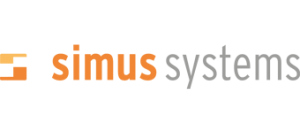
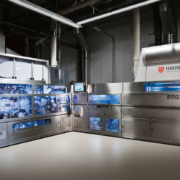 Hauni Maschinenbau GmbH
Hauni Maschinenbau GmbH
